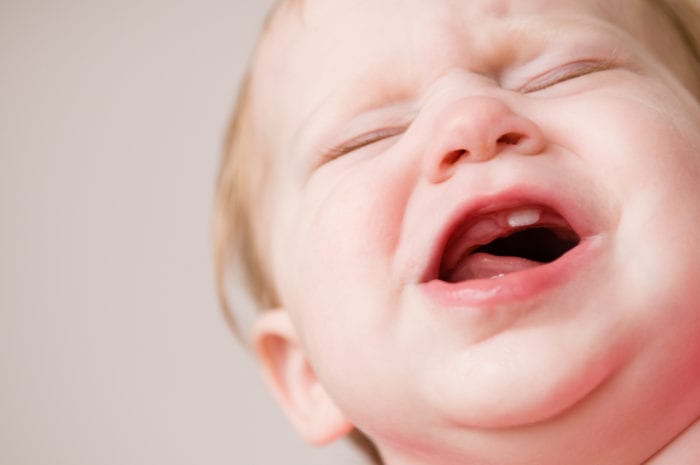Written by Amanda Banks, RDH
Before teething happens
It is recommended that once a day you take a clean wet cloth and gently wipe the baby’s gum ridges, inside of cheeks, lips, and tongue. You can do this at bath time, and baby will become accustomed to it being part of the routine. It has been my experience that a baby doesn’t mind, as they often try to put everything in their mouth and nom on it anyways.
Here’s a video of someone demonstrating gum care on a baby. You’ll see it’s quick and easy!
https://www.youtube.com/watch?v=bYZx_jgeHyU
Here’s what parents first notice about teething
- Excessive chewing and drooling
- Irritability
- Change in appetite
- Interrupted sleep patterns
- Crying
- Note: fever or diarrhea are not generally related to teething and you should consult your physician if you notice this
A teething period is usually defined as an 8-day window surrounding the emergence of a tooth. So, typically the child will be bothered a few days before and then a few days after the tooth comes in. Teething is difficult to research partly because it happens before the child is able to speak and so we must rely on parent and caregiver observations to try and know what the babies are going through. There is a tendency to blame every random symptom on teething, so that makes it tough also. The same child might also have different symptoms when the first teeth emerge than they will later on when their molars come in. You may also have noticed that the symptoms listed above can be seen in almost any baby on any given day, making it tough to know when teething is happening unless you can actually see the teeth below the gums.

Here we go! Let’s get technical
The latin term for teething is dentitio difficilis which means difficult dentition (most people would consider this an apt description I think). We dental people generally refer to the appearance of the teeth as “eruption.” Eruption is often defined as “the emergence of the tooth through the gingiva” but can also be defined as the movements the tooth makes to attain and maintain its relationship with the other teeth. As a generalization, the lower teeth of a type will emerge before the upper tooth of the same type. So, the lower canine teeth will emerge before the upper canine teeth, the lower molars will emerge before the upper molars, etc. The order of eruption is central incisor, lateral incisor, first molar, canine, second molar (though this can vary and if it does a trend will often be seen within a family). It is interesting to note that girls usually get their first tooth before boys.
You will see these primary teeth for the first time when they erupt into the mouth, but they have been around for a while. The hard tissue of the teeth begins to form in utero at around 4-6 months, and the crown portion of the tooth is completed at 1 ½ – 10 months of age (the roots finish forming later after the eruption). We aren’t going to talk much about permanent teeth, but it’s cool to note that all of the permanent teeth (except wisdom teeth) start forming by 3 years of age (well, I think it’s cool, but I’m kind of a nerd about these things).
Approximate Eruption Timing
| Mandibular (lower) | Maxillary (upper) | |
| Central incisors | 6 months | 7 ½ months |
| Lateral incisors | 7 months | 9 months |
| Canine | 16 months | 18 months |
| First molar | 12 months | 14 months |
| Second molar | 20 months | 24 months |
Okay, all of that’s nice, but help me soothe the crying baby!
As tempting as they sound, over-the-counter numbing solutions are generally not recommended. They generally contain a strong anesthetic that is difficult to control and could numb the entire oral cavity and, if swallowed, suppress the gag reflex. If you do choose to use any kind of topical gel, you’ll want to make sure that it doesn’t contain benzocaine (can in rare cases lead to methemoglobinemia, a condition that causes oxygen shortages in the blood and can be fatal), lidocaine or aspirin (aspirin is a no-no for babies and children largely due to its association with Reye’s syndrome, a rare but potentially lethal syndrome characterized by acute liver failure and brain swelling), and use it exactly according to the directions. For questions, talk to your pediatrician.
You should also avoid homeopathic remedies including amber bead necklaces which pose a choking and strangulation hazard. Oh, and if your grandmother tells you to put whiskey on the baby’s gums, just tell her that you’ll be keeping the whiskey to yourself because that doesn’t work either.
The best option is just giving them something to chew on. A cold washcloth or a hard teething ring are great options. You can also just rub their gums for them with a clean finger.
For teething product recommendations, check out these articles on Lucie’s List (basically THE website for reviews and recommendations on baby gear)
https://www.lucieslist.com/baby-tooth-care/
https://www.lucieslist.com/best-teethers/
Now that the teeth are here, you have to keep them clean!
Once the first tooth has erupted, you get to start the twice-daily brushing routine. Use an age-appropriate toothbrush, with a small smear of fluoridated toothpaste or water. Just as we recommend for adults, replace the baby’s toothbrush every few months. When brushing, remember to lift the lip out of the way for proper brushing of the front teeth.
Crazy stuff you probably didn’t know
Natal teeth – “Natal teeth” are teeth present at birth. Thankfully it is not common. There’s also “Neonatal teeth” that erupted 30 days after birth. Natal teeth are usually found in the lower incisor area, where the first primary teeth would be expected. Histologically, they are keratinized epithelial structures without roots, and therefore not true teeth. The recommended treatment is removal, once it has been determined that they are not prematurely erupted primary teeth.
In the olden days, teething was sometimes considered a cause of death!
Facts that I borrowed from Lucie’s List:
- From the 1500s through the 1800s in France, about half of infant deaths were documented as due to teething.
- In a single year in the late 1830s, more than 5000 deaths in England and Wales were recorded as teething deaths.
- In the 1840s, the English Registrar-General estimated that 12% of deaths of children under the age of four were the direct result of teething.
- According to Utah pioneer records, between 1847 and 1881, 521 deaths were attributed to teething.
- Even as late as the 1910s, infant and childhood deaths were still ascribed to teething.
Thanks to modern medical knowledge, now we know this was all just coincidence. These “teething deaths” were probably caused by things like cholera, dehydration, and a myriad of other common early-childhood illnesses that are no longer threats. Needless to say, teething was a terrifying time for parents – literally a period to be survived.
Once a child had all his teeth, his parents could finally breathe a sigh of relief. Phew! Made it!
To read more from Lucie’s List article or see the sources you can go to this web page:
https://www.lucieslist.com/newsletter/introduction-teething/
